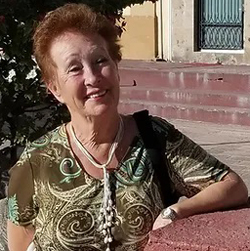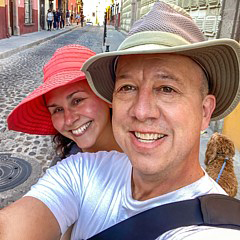by Natalie Taylor with photos by Jack Paulus
In my last article about the Santa Casa, housed inside the Capilla de Loreto, I spoke about some of the art stored within. The chapel holds some truly wonderful examples of paintings, and sculptures done by the artists of New Spain, in the 18th and 19th Century. Inside the sacristy, a wall is lined with paintings of the seven archangels, all very well executed and painted on laminated copper. The largest one, however, a painting of Saint Michael the Archangel—patron of our city—is on canvas. These excellent works were executed by one of the most important novo-Hispanic painters, Juan Patricio Morlete Ruiz, a native of San Miguel el Grande, born in 1713.
Along the same wall are other paintings; these are depictions of famous converts—the painters are anonymous, however. One, specifically pointed out by Father Juan Francisco, who led us through the chapel, was that of Saint Mary of Egypt. Her story is that she ran away from her parents at 12 and became a prostitute in Alexandria. After 17 years she converted, and retired to the desert to live the life of an ascetic. She represents fallen women—like Mary Magdalene—who changed their lives after finding religion. The painting is one of about a dozen others all about such conversions, and part of traditional Church lore.
Opposite the wall with the archangels, there is an impressive full-wall painting that, at first glance, appears to be a mural. It is, however composed of several panels painted on canvas and was done by another well-recognized novo-Hispanic painter of the late 18th century, born in Mexico City. There is indeed a signature, and a date: Andreas Lopez, 1795.

To the left of the signature one can see a splotch on the painting. This, it was explained, happened when a caretaker left the window above it open, and the painting was damaged by rain drops.
The entire panel is a depiction of the Sagrado Corazon de Jesus—the Sacred Heart of Jesus, and according to Father Juan Francisco, Lopez studied with Miguel Cabrera, who was considered the best Spanish painter in his lifetime. The painting is very well done, with well-proportioned figures of angels and saints, and realistic interior scenes.

One unique painting is special because it records a particular event in San Miguel in the 18th century. It is perhaps a meter and a half by a meter, and hangs some six meters off the ground. Darkened with age, the subject can hardly be perceived with the naked eye. A framed inscription at eye level, tells the story.
On October 14 of 1760, a ten-year-old boy named Miguel Joseph de Vallejo fell as he was coming out of school. Seeing a horse-drawn carriage careening toward him, he called out for help to the Virgin of Loreto. When the wheels of the carriage struck him in the head, he lay immobile on the ground bleeding profusely from nose, mouth and ears. He was taken home, where both a doctor and a surgeon said he would not last the night. However, in the morning he awoke feeling much better, and soon became well. Within a day, his grateful father commissioned the painting, giving credit to the Virgin for his son's recovery. The painting reveals the scene described, with the carriage passing along the road between churches, the boy sprawled on the ground, and people rushing to his aid—a depiction of San Miguel el Grande at that time. It was only when Jack Paulus used his tripod and zoomed in on it, that the painting could be seen, and photographed. Father Juan Francisco was quite impressed as he looked through the lens because he himself had never seen the painting up close.

The entire chapel is filled with opulent decorations. The lavish gold on the altar, on the capitals of the columns, in the enclosures, and on the statues is impressive. The sculpted figures of Tomas de la Canal, and his wife, within decorated niches are excellent, and are the only depictions of their likeness in our city, that I know. The remains of each rests in individual tombs beneath.


Within the chapel, one can admire the high dome which was added much later, in the 19th century. It is encased by windows that let the light in, elaborate decorations along the borders, and about a dozen glittering crystal chandeliers.


The hallway to the left, shows many lavish decorations and architectural details. The elaborate cornice over the door, for example, includes a statue of a frolicking child-angel. There are several beautifully painted panels along that same wall, and the half-wall, which separates the hallway from the actual Santa Casa, is trimmed along its length with rich wood, inlaid with a floral design. At the end of the hallway, turning left, brings you to a giant iron gate through which you can glimpse the interior of the Oratorio church. From inside the Oratorio, you can glimpse the chapel of Loreto. However, you would not be able to see the Santa Casa from that vantage point.
Everything, from the polished wooden floor, to the arched ceiling is a reminder of the wealth of San Miguel de Allende during the 18th and early 19th centuries. The city was then a center for wealthy Spanish merchants who had settled in New Spain, and whose dedication to the Catholic Church—and a desire to be in its good graces—motivated them to spend great amounts of money to show their devotion. The Chapel of Loreto was Tomas Manuel de la Canal's project, and funded by him. The construction began in 1734, just two years after his arrival in San Miguel el Grande, but it was not completed until after his death in 1749.

Among all these riches, what most impressed me was the ceiling in the room beyond the sacristy. It is completely covered by a magnificent trompe l'oeil that one might think is ceramic or wood, but instead is ancient tapestry. Sadly, it will be stripped shortly to reveal the wooden beams. These need to be inspected for structural soundness, and ability to bear the weight of the roof. It will be impossible to preserve this treasure once it starts to be taken down, it will only remain in memories and photos. This is another reminder of the ethereal nature of all the art in our city, and the need to preserve and document it.
**************

Natalie Taylor, born to Ukrainian parents, grew up in Argentina, where her family fled after WWII. They eventually moved to the U.S., and she spent most of her adult life there. She has a journalism degree, and an MFA in creative writing from Vermont College, Montpelier, VT. Her short stories, and poetry have been published in numerous literary magazines, and she has received several literary awards. She and her husband currently reside in San Miguel, where she has a weekly column in Atención, for which she also does translations. She has two books about San Miguel, available on Amazon or at the Tesoros Book Store: "Of All the Towns in All the World," and "SMA Self-Guided Historical Walking Tour." Her memoir, "The Tango House," will be coming out soon.
www.natalietaylor.org
**************

Jack Paulus has lived in SMA for a year and a half but this was his first Semana Santa. Before moving here he spent decades in the movie industry (Pixar). There expressing creativity collectively involved hundreds of other people. He observes, "I have been taking photos since the age of 12 and now I enjoy capturing life around me in images in a solo capacity."
www.jackpaulus.com
**************
*****
Please contribute to Lokkal,
SMA's online collective:
 ***
***
Discover Lokkal:
Watch the two-minute video below.
Then, just below that, scroll down SMA's Community Wall.
Mission

Visit SMA's Social Network
